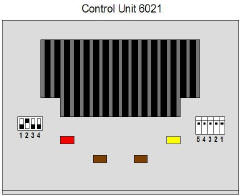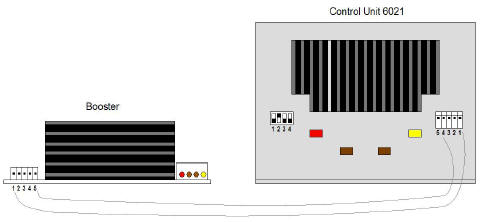Do-It-Yourself Booster for the Märklin Motorola and DCC Format
The following considerations made me design my own booster:
| The factory made boosters are expensive | |
| The maximum output current is limited to 2.5 to 3A, depending on the manufacturer | |
| Several boosters are needed for a layout, so a do it yourself project is not limited to a single part, making the development interesting. | |
| The pleasure in developing
and building electronics. |
|
The main current to be switched by means of a relay. | |
|
Reset and start buttons (and therefore crawling under the railway after every short circuit) | |
|
Complicated wiring. |
|
| Can be operated from any standard model railway transformer (18 VAC). |
|
| Output current from 3 to 6 Amps, therefore suitable for all gauges. |
|
| Interfaces directly to the booster interface of the Märklin Control Unit (6021), the Uhlenbrock Intellibox, the Fleischmann Twin Centre and the TAMS Easy Control. |
|
| Stop / Go function from the Control Unit with display (LED). Emergency stop possible, even using PC control. |
|
| Short circuits are passed through to the control unit (CU goes to stop if a short circuit occurs in a booster powered part). |
|
| Connection for additional boosters. |
|
| Use of only standard parts. |
|
| Easy to build. |
|
| Considerable less cost as factory made boosters. |
|
| Absolutely reliable operation. |
|
| Can be used for Märklin Motorola (MM und MM2), DCC and combined. |
All these points are fulfilled at full extent with the booster presented here.
Further considerations
Many of the available booster kits can not be connected to the booster interface of the control unit, instead they must be attached to the rails of an other circuit or to the rails output of the CU (brown and red). Here the same signal is available, only the level (and naturally the output current) is higher. This signal is used as the input for these boosters. This system has however a serious disadvantage: If it comes to a brief short circuit in the electrical circuit of the control unit, also the signal for all further boosters is interrupted in this time. The consequence: every small short-circuit affects the entire layout. The booster interface of the Control Unit on the other hand would still have been supplying the digital signal, in fact the signal is available even when the stop key of the CU has been pressed. The second disadvantage not using the booster interface is that the booster can not switch off the CU in case of a short circuit in its own circuit (feedback).To clarify this, the different ways of connecting the boosters are shown schematically:
 |
| Above the version with a conventional booster kit. If it comes to a short-circuit in the electric circuit 1 (perhaps only short, without the control unit switching off), the booster and thus the electric circuit 2 likewise get no data. Disturbances over the whole layout are the result. |
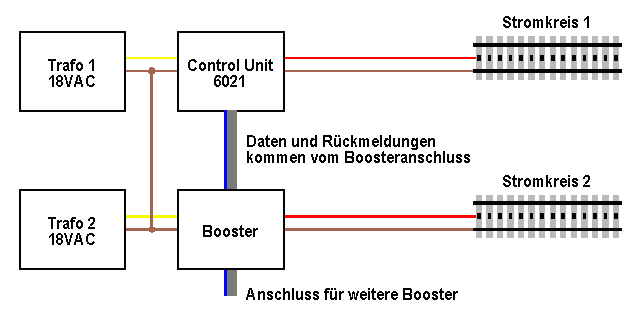 |
| The booster presented here uses the booster connection (booster interface) of the cu 6021 or the Intellibox instead. Result: Electric circuit 2 is supplied correctly with data, even if it comes to small short-circuits in the electric circuit 1. The wiring is simple, there data and feedback use only one 5-pin plug/cable. |
The connections at the booster interface of the cu 6021 and Intellibox are as follows:
|
Data | Digital signal | ||
|
Go / Stop | Function of the keys Go and stop of the cu. | ||
|
DC output | This pin is not used with the cu. | ||
|
Ground | Electronic ground (GND). | ||
|
Short circuit | Short circuit feedback of the boosters to the cu. |
To ensure the compatibility these functions must be used in our booster.
A stabilization of the output voltage has not been implemented, after a series of intensive tests and measurements. Why? In order to stabilize an output voltage, the input voltage must be significantly higher. Transferred to our application this means that the input voltage would have to be larger than 18V, i.e. at least approx. 20V. Thus meaning that all standard model railway transformers are omitted. The alternative is to make the output voltage smaller. This naturally has different negative effects, like increased contact problems, general under voltage for decoders and magnetic devices etc..According to my opinion it's better beginning with a generous dimensioning of the transformers and boosters, as well as - very important - the sufficient cross sections of the wiring.
Circuit
The output stage
For the output stage I selected high current Darlington transistors : TIP140 (T6, NPN) and TIP145 (T5, PNP). I choose an arrangement, which makes the direct assembly of both transistors on a heat sink without isolation possible. This is done by connecting the two collectors of these transistors. The control of the output stage happens with the two transistors T1 and T2. The output current is limited by the transistors T3 and T4. These receive the base voltage from the resistances R7 and resp. R8. If the voltage drop over these resistors exceeds a value of approximately 0.6 Volt, they become conductive thus "taking away" the input signal of the Darlingtons. By changing the value of R7 and R8, the maximum output current be adjusted:|
Output current |
R7 resp. R8 |
C1 resp. C2 |
C1' resp. C2' |
Q1 |
Transformer |
|
3.3A |
0.18Ω |
4'700μF |
- |
B80C3000 |
60VA |
|
4A |
0.15Ω |
10'000μF |
- |
B80C5000 |
72VA |
|
5A |
0.12Ω |
10'000μF |
4'700μF |
B80C5000 |
90VA |
|
6A |
0.10Ω |
10'000μF |
10'000μF |
B80C5000 |
108VA |
Table 1: Parts depending on the desired output current.
The current supply
A commercial model railway transformer is used for the 18V AC supply for the booster. This must be able to supply the desired output current. For the maximum current of 6 ampere a transformer of at least 108VA is necessary. For lower output current both resistors R7 and R8 must be adapted according to table 1.
The voltage is rectified by Q1, using a simple half-wave rectification. It becomes thus the positive half wave for the plus voltage, and uses the negative half wave for the minus voltage. This method has the advantage that only one secondary winding (one transformer) is needed. However the expenditure for the smoothing becomes more highly than during a full-wave rectification. Therefore the circuit is laid out for capacities up to 20'000 μF for each for DC voltage (total of 40'000 μF!).
Control
The remainder of the circuit is for the control, input and output signals etc.. A signal quality is ensured by using comparators (Q3).
Structure
For the circuit I developed a printed circuit board with the dimensions 160 x 100 mm, which is euro-format. This size PCB easily available are as photo lacquer coated, one side copper-covered GRP plates in Europe. All parts are accommodated on this print. The design is based on standard parts, not using any SMD devices. It should therefore be no problem for DIY.
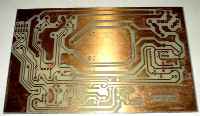 |
This is how the finished printed circuit board for the first prototypes looked. |
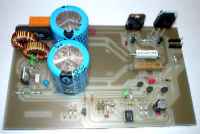 |
The first
prototype booster, equipped with only two capacitors for measuring purposes only (each 10'000µF). The layout of the printed circuit board was refined afterwards. |
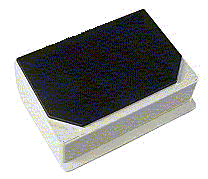 |
Our booster fits perfectly in such a desk case. The housing is exactly one and a half times as wide as a Maerklin
booster 6017. It is available from the Conrad (part number 211990) |
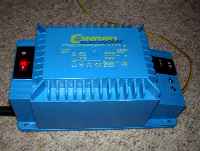 |
With such a
transformer one has enough power reserves. The rated output amounts to 150VA!
The advantage is obvious: Even under heavy load the output voltage does
not sink all too much. The switch serves also as an overload
safety device. In addition the output voltage can be switched from 18V
to 15V. By using such high current transformers large cross sections with the wiring (1mm 2 or more) must however be absolutely respected! |
Both Darlington transistors are screwed on as large as possible heat sink. Hereunder applies the following to consider: From a technical view it's not necessary to insulate the transistors to the heat sink. However, the output voltage of the booster is then on the entire heat sink. In that case the heat sink may not have any connection to other live parts or to ground! Safer is therefore the insulated assembly of the transistors.
 |
The circuit looks more complicated at first sight, than it is. Many parts serve the control and feedback for the control unit 6021 or the Intellibox. The booster can be called rightfully Plug and Play equipment. If soldering knowledge is present, the building of this boosters is no problem at all.
Oscilloscope pictures of the output signal
The output signal was measured under practice close conditions and compared with the output of a 6021. Click here to view the results.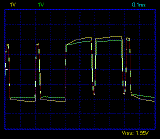
Boosters Connections
The boosters come with a five pin interface connection, that must be wired 1:1 to the booster interface of the Control Unit 6021, the Intellibox, the Fleischmann Twin Center or the TAMS Easy Control. The boosters you can buy in the shop come with a 14 inch cable.
Connect brown and yellow to the output of your transformer and brown and red to the tracks (brown = ground).
Notice regarding the Intellibox or the Twin Center
If you plan to operate the Intellibox with attached booster also in the DCC mode, then
the special option 901 must be set to 3, otherwise the boosters send a short circuit message.
This is not a characteristic for the boosters presented here, but must be done also with other boosters (e.g. 6015 and 6017).
Further information and parts
Do you need additional information? Then do not hesitate to contact me by using my feedback form. I will then mail you all plans needed.
Parts and built modules
In my shop you may order single pcbs with or without all the parts needed or complete and tested devices.
Page created:
Last changes:
20.05.2005
24.11.2010
